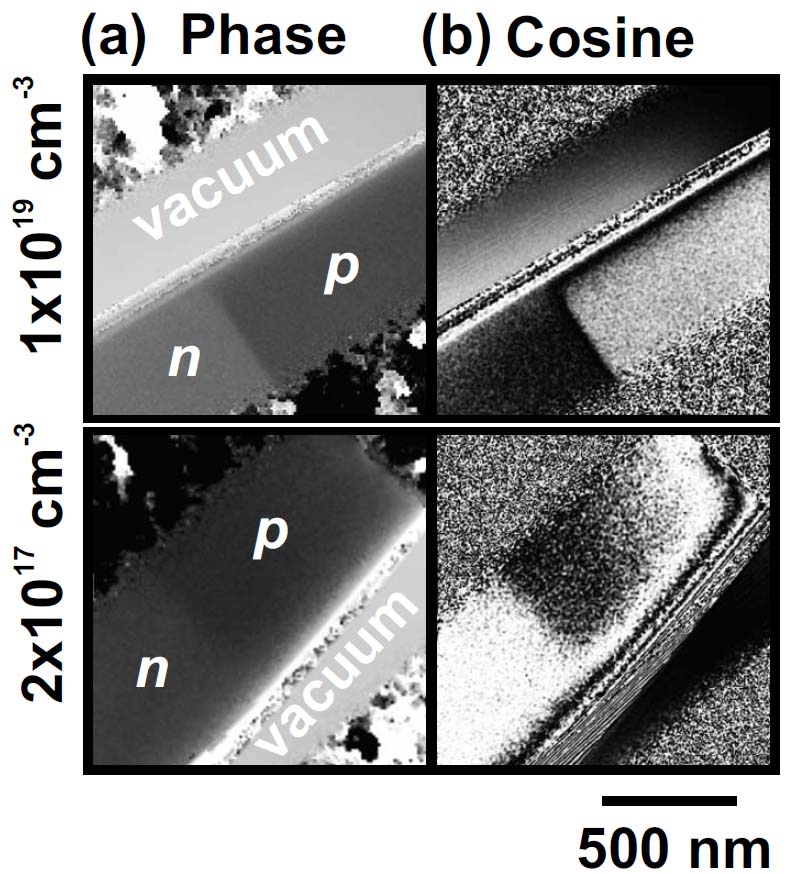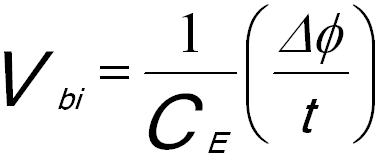=================================================================================
Research and engineering applications of off-axis electron holography can be split into three main categories:
i) Correct microscope aberration to achieve high spatial resolution;
ii) Measure electric fields in materials at high spatial resolution;
iii) Measure magnetic fields at high spatial resolution.
Off-axis electron holography has been widely applied to characterize p-n junction specimens prepared using focused ion beam (FIB) technique. When there are no magnetic fields and diffraction contrast from the p-n junction, the change in phase of an electron as it passes through the specimen is given by, [2]
 ------------------------------ [4305a] ------------------------------ [4305a]
where,
CE -- The interaction constant between the fast electrons and matter, dependent on the energy of the electron wave (e.g. 7.29 x 10−3 rad V−1 nm−1 for 200 kV electrons),
V -- The electrostatic potential, or called the mean inner potential (MIP in V).
t -- The local thickness of the specimen,
z -- The electron beam direction. [1]
Therefore, the phase of an electron is very sensitive to changes of dopant-induced potential in the specimens.
In order to optimize the acquisition of holograms, in many cases, the microscopes need to be re-configured. For instance, Cooper et al. [2] turned off the probe corrector in their FEG FEI Titan microscope even though it had been installed. Both the objective lens and third condenser lens were turned off, and a Lorentz lens was used in order to extend the holographic field of view to 1500 x 700 nm2. Consequently, the fringe spacing in the holograms was 3.5 nm, resulting in a spatial resolution of ~10 nm in the reconstructed phase images.
Figure 4305 shows examples of the phase images and cosine images of phases reconstructed from recorded holograms from p-n junctions at two different concentrations. The specimen thicknesses were ~400 nm determined by CBED. Two phenomena are very clear:
i) The p-n junctions in the phase images do not extend all the way to the specimen surface, especially for low dopant concentrations.
ii) The near-surface of p-doped region appears to be at the same negative potential as the n-doped layers in the junctions, due to surface charge.

Figure 4305. (a) Phase images and (b) Cosine images of their phases for p-n junctions with the different dopant concentrations.
Adapted from [2]
From Equation 4305a, we can know that the built-in potential Vbi in the p-n junction can be measured by, [2]
 ------------------------------ [4305b] ------------------------------ [4305b]
Note that for a FIB-prepared specimen, there is an electrically inactive layer on both surfaces so that t needs to be replaced by t-tinactive. Here tinactive is the total thickness of the inactive layers on both sides of the TEM specimen.
[1] W. D. Rau, P. Schwander, F. H. Baumann, W. Hoppner, and A. Ourmazd,
Phys. Rev. Lett. 82, 2614 (1999).
[2] David Cooper, Pierrette Rivallin, Jean-Michel Hartmann, Amal Chabli, and Rafal E. Dunin-Borkowski, Extending the detection limit of dopants for focused ion beam prepared semiconductor specimens examined by off-axis electron holography, Journal of Applied Physics, 106, 064506 (2009).
|

 ------------------------------ [4305b]
------------------------------ [4305b]